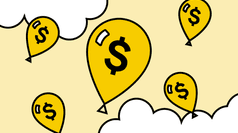What is inflation? Shedding light on the causes, types and remedies
April 12, 2023
10 min

What is inflation? It’s mostly linked to rising prices, but do you know what causes it and how to combat it? Let’s discover the different types of inflation, how to measure it and some solutions in this guide.
What is inflation: meaning and definition
Understanding what inflation is, seeking its meaning and definition, is one of the first steps in financial education: it is an economic issue that affects everyone in their daily lives. In short, it’s the increase in the general level of prices, accompanied by a decrease in the purchasing power of money. Basically, money loses value, so over time the same amount of money can buy fewer goods and services of lower quality.
The reduction in spending power is the consequence that best explains what inflation is. In fact, the data shows that the purchasing power of the Euro has decreased by about 34% since it has been in circulation, without taking into account the recent combination of the energy crisis, the war in Ukraine and the Covid health emergency. This means that, in 20 years, the value of 1000€ has decreased to correspond to 660€ today.
This explains what inflation is, but the real meaning is much broader. Rising prices, in fact, besides the immediate effects on individuals’ savings, have indirect effects on Gross Domestic Product (GDP) and the unemployment rate. In a nutshell, inflation is the tipping point: if purchases sustain companies, which can therefore continue to produce goods, they are able to pay wages to workers, thus feeding the money cycle again. It is difficult to maintain the balance between these variables, which, in fact, in certain situations can be causes of inflation, as we will see later.
Given this mechanism, the definition of inflation seems only negative, but a steady and moderate increase in the rate is actually an indication of economic growth: it frames an increase in consumption and productivity, without excessive devaluation of the currency. This is why the European Central Bank (ECB) is committed to maintaining a symmetric inflation rate of 2 per cent over the medium term, thus preventing both upward and downward deviations.
How to fight inflation: interest rates and QE
Now that we know what inflation is, we can study the tools used by the ECB to maintain the optimal level (2%). The first method consists of raising, or lowering, interest rates, i.e. the additional portion of loans that borrowers have to repay to banks. The following steps, in brief, explain how the European Central Bank tries to combat high inflation:
- The ECB raises its interest rates for deposits and loans;
- It is more expensive for domestic and commercial banks to demand liquidity. Therefore, they increase their interest rates for loans to private individuals;
- For citizens, therefore, debt is more expensive: since they cannot obtain financing for their expenses, they have an incentive to save;
- This should lower the demand for goods and services and, theoretically, lower supply prices, thus reducing inflation.
Conversely, when deflation threatens economic growth by excessively reducing prices, the ECB lowers interest rates to stimulate demand and investment.
Having a clear understanding of the meaning of inflation, it is logical to think that raising interest rates will only have its effects in the long term, however, there is an important consequence in the short term: expectations linked to high interest rates. This is important because, without the ECB’s monetary policies, workers might expect high inflation to be irreversible: this would convince them to demand higher wages, consequently causing the prices of their companies’ products and services to rise. This phenomenon, called wage-price spiral, is one of the most feared effects of inflation.
Saving, as opposed to lending, is made easier by higher interest rates: bank deposits are rewarded, because banks will return more profit on the capital taken in. To combat inflation, the European Central Bank can also intensify or ease the reserve requirements imposed on national and commercial banks. In practice, financial institutions have to keep a part of their deposits with the ECB: when this percentage increases, banks can lend less and by definition inflation should decrease.
Finally, to normalise prices, the ECB can resort to unconventional measures, such as quantitative easing (QE) and tightening (QT). In a nutshell, when interest rates cannot be lowered any further, because they are close to zero, but the economy is still stalled, central banks buy government bonds, thus injecting liquidity into the banking system. The increased supply of money, given by quantitative easing, thus encourages lending and should bring inflation back to optimal levels.
In contrast, the ECB in Europe and the Federal Reserve (FED) in the US apply quantitative tightening to lower inflation: they do not renew at maturity or sell government bonds, so as to decrease the money in circulation.
Causes and types of inflation
To go deeper into what inflation is, we can discuss its possible causes and the different types that exist. For example, at the end of 2022, the ECB used QE to boost the economy: the money received by European governments was transformed into economic subsidies, but the liquidity injected into the states led to an excessive increase in prices. This first type of inflation is called ‘demand inflation’ and is well explained by Milton Friedman, economist at the University of Chicago: “Inflation is caused by too much money chasing after too few goods“.
According to this definition of inflation, the rapid increase in aggregate demand, given by economic incentives, has outstripped the supply of goods and services, causing prices to rise: it is a simple consequence of the law of supply and demand.
In contrast, the cause of supply (or cost) inflation is connected to the production processes. Rising raw material prices, wage costs, or supply chain costs increase the financial burden on companies, which are thus forced to increase the prices of final products. For example, rises in the price of oil, caused by OPEC decisions, increase the cost of petrol, and thus of goods transported by land and sea, also affecting flight fares.
We can also explore the meaning of inflation and the types from a statistical point of view: when the rate is below 10%, but moderate and constant, it is called ‘creeping‘. Conversely, inflation is ‘galloping‘ when it grows rapidly, exceeding 10 points, but does not go beyond 20 per cent. Some of the harshest periods in history, on the other hand, have witnessed a rate in excess of 50%, referred to as ‘hyperinflation‘. Finally, when price increases are associated with a period of economic stagnation, we speak of stagflation.
Calculating inflation: consumer price indexes
Monetary policy discussions at ECB meetings are based on certain measures of the inflation rate. The most widely used is the Consumer Price Index (CPI): it considers the change in the cost of a basket of goods and services. Each has a different weight, based on the average of popular spending habits, and is adjusted annually by the national statistical institutes.

The Harmonised Index of Consumer Prices (HICP) is the CPI generalised to the entire Euro area, because it is calculated using the same methodology for each EU country. In fact, the ECB aggregates the HICP data from the Euro states in order to obtain an overall view on the inflation rate, on which to base its interventions. However, to make long-term estimates, it is often preferred to consider core inflation, a measure that excludes food and energy prices, which tend to fluctuate more in the short term, from the basket.
FOMC decisions at FED meetings, on the other hand, also consider the Personal Consumption Expenditure Index (PCE): it collects more consumption items than the CPI, using data directly from GDP and suppliers.
How to defend against the effects of inflation?
In explaining what inflation is, we anticipated that rising interest rates stimulate savings, to the detriment of loans. However, this side of the coin should not mislead you: higher returns on deposits are also subject to inflation. According to the Fisher effect, if your bank promises an annual interest rate of 4% on your deposits, but inflation is at 5%, the value of your savings does not increase, but rather decreases by 1%.
In addition to the definition of inflation, therefore, one must know the difference between:
- Nominal interest: rate (percentage) agreed with the bank, at the opening of an account or at the same time as a loan, financing or mortgage. It is the theoretical cost of a loan and the yield, again theoretical, on the savings deposited.
- Real interest: effective interest rate, for loans and deposits, net of the inflation rate, calculated as the difference between the latter and the nominal interest rate.
The real interest rate of deposits, therefore, is often negative: inflation reduces the purchasing power of your money so much that it cancels out the added value generated by your savings.
Let’s take an example: in August 2022, the inflation rate in the UK stood at 9.9% year-on-year, as stated by the ONS, one of the highest in recent history. Let us assume that the year before, the most generous commercial bank gave you a nominal annual interest rate of 5% on deposits. So, if you had deposited £1000, in August 2022 you would have about €1050 in your account, but the real purchasing power of your capital, adjusted for inflation, was about £946. The real interest rate was in fact -4.9% (5%-9.9%).
Considering these effects, we can really understand what inflation is: your savings only lose value by remaining passively deposited in a bank account.
Furthermore, an analysis conducted in countries with a high adoption of cryptocurrencies, published in Axioms 2022, found an alternative for inflation protection in Bitcoin. In fact, according to an in-depth study, BTC was shown to withstand inflationary shocks better than stocks and some safe-haven assets (such as gold) in both stable and turbulent economic regimes.
Discovering the meaning of investing, then, is the natural continuation of this guide on what inflation is, having discovered its meaning and definition. Alternatively, you could immediately look into financial instruments for your personal solution to rising prices, but always consider the risk involved in investing: you could lose more than inflation has already taken from you!
